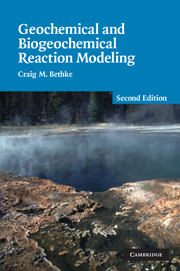Book contents
- Frontmatter
- Contents
- Preface
- Preface to first edition
- A note about software
- 1 Introduction
- 2 Modeling overview
- Part I Equilibrium in natural waters
- Part II Reaction processes
- 13 Mass transfer
- 14 Polythermal, fixed, and sliding paths
- 15 Geochemical buffers
- 16 Kinetics of dissolution and precipitation
- 17 Redox kinetics
- 18 Microbial kinetics
- 19 Stable isotopes
- 20 Transport in flowing groundwater
- 21 Reactive transport
- Part III Applied reaction modeling
- Appendix 1 Sources of modeling software
- Appendix 2 Evaluating the HMW activity model
- Appendix 3 Minerals in the LLNL database
- Appendix 4 Nonlinear rate laws
- References
- Index
13 - Mass transfer
Published online by Cambridge University Press: 05 August 2012
- Frontmatter
- Contents
- Preface
- Preface to first edition
- A note about software
- 1 Introduction
- 2 Modeling overview
- Part I Equilibrium in natural waters
- Part II Reaction processes
- 13 Mass transfer
- 14 Polythermal, fixed, and sliding paths
- 15 Geochemical buffers
- 16 Kinetics of dissolution and precipitation
- 17 Redox kinetics
- 18 Microbial kinetics
- 19 Stable isotopes
- 20 Transport in flowing groundwater
- 21 Reactive transport
- Part III Applied reaction modeling
- Appendix 1 Sources of modeling software
- Appendix 2 Evaluating the HMW activity model
- Appendix 3 Minerals in the LLNL database
- Appendix 4 Nonlinear rate laws
- References
- Index
Summary
In previous chapters we have discussed the nature of the equilibrium state in geochemical systems: how we can define it mathematically, what numerical methods we can use to solve for it, and what it means conceptually. With this chapter we begin to consider questions of process rather than state. How does a fluid respond to changes in composition as minerals dissolve into it, or as it mixes with other fluids? How does a fluid evolve in response to changing temperature or variations in the fugacity of a coexisting gas? In short, we begin to consider reaction modeling.
In this chapter we consider how to construct reactions paths that account for the effects of simple reactants, a name given to reactants that are added to or removed from a system at constant rates. We take on other types of mass transfer in later chapters. Chapter 14 treats the mass transfer implicit in setting a species' activity or gas' fugacity over a reaction path. In Chapter 16 we develop reaction models in which the rates of mineral precipitation and dissolution are governed by kinetic rate laws.
Simple reactants
Simple reactants are those added to (or removed from) the system at constant rates over the reaction path. As noted in Chapter 2, we commonly refer to such a path as a titration model, because at each step in the process, much like in a laboratory titration, the model adds an aliquot of reactant mass to the system. Each reactant Ar is added at a rate nr, expressed in moles per unit reaction progress, ξ.
- Type
- Chapter
- Information
- Geochemical and Biogeochemical Reaction Modeling , pp. 193 - 200Publisher: Cambridge University PressPrint publication year: 2007

